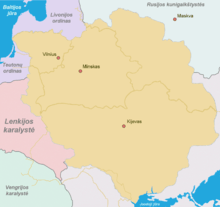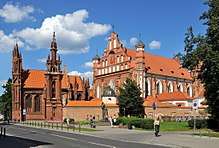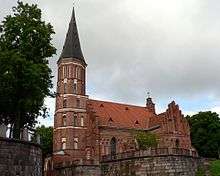Gothic architecture in Lithuania
Lithuania is not the very centre of Gothic architecture, but it provides a number of examples, partly very different and some quite unique.


Conditions
Lithuania, situated at the border of Greek[1] and Roman Church had developed by the defence of its paganism, especially against the Teutonic Order to become a state and in the 14th century a major power. The territory of nowaday's republic, except Lithuania Minor, which was ruled by the Teutonic Order, was the Lithuanian speaking part of the Grand Duchy of Lithuania, with its Slavic and Orthodox majority of subjects. The centre of power of this large state lay among Kaunas, Trakai and Vilnius.
By the marriage of Grad Duke Władysław II Jagiełło and the polish Queen Jadwiga, the personal union of Lithuania and Poland began. After the Battle of Grunwald in 1410 and by the Treaty of Melno in 1422 the attacks of the Teutonic Order ceased. After the Second Peace of Toruń, the Order was not any more a serious competitor against the two monarchies joined by personal union.
Buildings
Castles with hard walls
.jpg)
Castles built of stones and bricks, dates of the first complete building after wooden precursors:
- Kaunas Castle, built in the mid 14th century, explored by Teutonic Knights in 1361 and destroyed in 1362, in 1384 once more conquered by the Order and reconquered by the Lithuanians,
- Trakai Peninsula Castle, 1350–1377,
- Trakai Island Castle, Fortifications built in the second half of the 14th century, palace after 1410,
- Medininkai Castle, 1392, after mid 15th century residential
- Gediminas Tower in Vilnius, completed 1409.[2]
Almost all of the Lithuanians medieval castles and forts were built of wood and earth.

First churches
Orthodox cathedral of Vilnius
The oldest church in Lithuania, that has been built of bricks, is the Orthodox Cathedral of the Theotokos, Vilnius. It was constructed in 1346, when the Renaissance style had not yet arrived in central Europe, and in the Grand Duchy only the Slavic population was Christian. The roofs and the design of the outer walls underwent some chenges in the course of centuries. Today, the outer appearance is Neo-Byzantine, and most of the walls are plastered.[3]
Brick Gothic

After Władysław II had been baptized to be a Catholic, the country officially became Christian, and churches were built also for the Lithuanian population in the northwest of the Grand Duchy. Soon the most important churches were erected in Brick Gothic:
- Church of St. Nicholas in Vilnius, 1387
- Vytautas' the Great Church in Kaunas, about 1400
- St-George's Church (pl.wiki) in Kėdainiai, 1403
- Kaunas Cathedral Basilica, 1410, several times rebuilt and redesigned in Baroque style[4]
- Franziskan Church of the Assumption of Mary (fr.wiki) in Vilnius, after a wooden precursor of 1387 in bricks since 1410, several times destroyed by fire, since 1671–1675 mainly Baroque.
Late Gothic
Flamboyant style

In the period of late Gothic, in Lithuania two exceptional buildings were created, in abundant French Flamboyant style, but realized in bricks.
- The House of Perkūnas was built in the mid 15th century as a trading post of the Hanseatic League and had tha function till 1532. Afterwards it was used by the Society of Jesus. The present name is derived from a small picture that was found at the wall and was considered an image of a Baltic thunder god by romantic historicans.[5]
- Church of St. Anne, Vilnius, 1495–1500.[6]
Notes and Weblinks
- As late as 1448, the Russian Church split from the Greek one by choosing a Russian metropolite.
- "National Museum of Lithuania: History of Gediminas Castle Tower ". Archived from the original on December 28, 2015.
- "Вильнюсский Пречистенский Собор". bratstvoprav.narod.ru.
- "Jono Pauliaus II piligrimų kelias. Basilica". www.piligrimukelias.lt.
- Lithuanian inventory of monuments : Namas, vad. Perkūno
- "Sightseeing Vilnius - Vilnius city guide | St Anne's and Bernadine's Churches". www.sightseeing-vilnius.com.
| Wikimedia Commons has media related to Gothic architecture in Lithuania. |